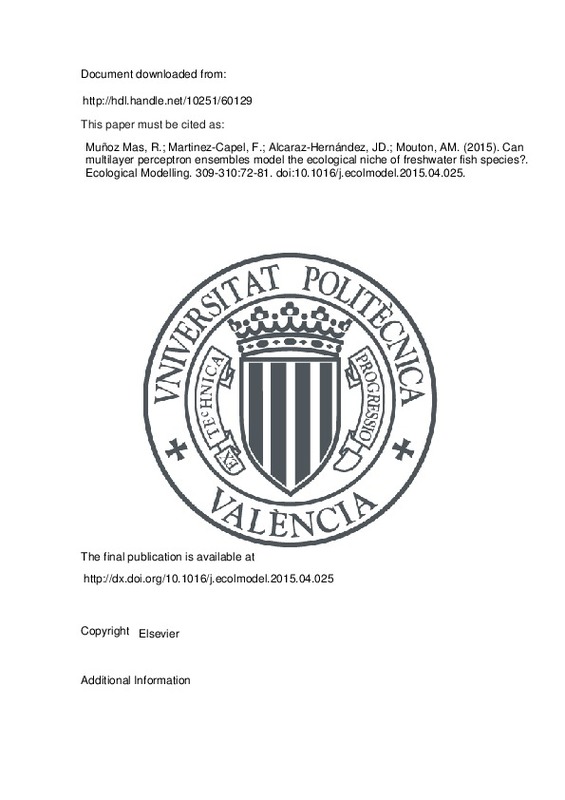JavaScript is disabled for your browser. Some features of this site may not work without it.
Buscar en RiuNet
Listar
Mi cuenta
Estadísticas
Ayuda RiuNet
Admin. UPV
Can multilayer perceptron ensembles model the ecological niche of freshwater fish species?
Mostrar el registro sencillo del ítem
Ficheros en el ítem
| dc.contributor.author | Muñoz Mas, Rafael
|
es_ES |
| dc.contributor.author | Martinez-Capel, Francisco
|
es_ES |
| dc.contributor.author | Alcaraz-Hernández, Juan Diego
|
es_ES |
| dc.contributor.author | Mouton, A. M.
|
es_ES |
| dc.date.accessioned | 2016-01-22T18:35:44Z | |
| dc.date.available | 2016-01-22T18:35:44Z | |
| dc.date.issued | 2015-08-10 | |
| dc.identifier.issn | 0304-3800 | |
| dc.identifier.uri | http://hdl.handle.net/10251/60129 | |
| dc.description.abstract | The potential of Multilayer Perceptron (MLP) Ensembles to explore the ecology of freshwater fish specieswas tested by applying the technique to redfin barbel (Barbus haasi Mertens, 1925), an endemic and mon-tane species that inhabits the North-East quadrant of the Iberian Peninsula. Two different MLP Ensembleswere developed. The physical habitat model considered only abiotic variables, whereas the biotic modelalso included the density of the accompanying fish species and several invertebrate predictors. The results showed that MLP Ensembles may outperform single MLPs. Moreover, active selection of MLP candidatesto create an optimal subset of MLPs can further improve model performance. The physical habitat modelconfirmed the redfin barbel preference for middle-to-upper river segments whereas the importance ofdepth confirms that redfin barbel prefers pool-type habitats. Although the biotic model showed higheruncertainty, it suggested that redfin barbel, European eel and the considered cyprinid species have similarhabitat requirements. Due to its high predictive performance and its ability to deal with model uncertainty, the MLP Ensemble is a promising tool for ecological modelling or habitat suitability prediction in environmental flow assessment. | es_ES |
| dc.description.sponsorship | This study was funded by the Spanish Ministry of Economy and Competitiveness with the project SCARCE (Consolider-Ingenio 2010 CSD2009-00065) and the Universitat Politecnica de Valencia, through the project UPPTE/2012/294 (PAID-06-12). Additionally, the authors would like to thank the help of the Conselleria de Territori i Vivenda (Generalitat Valenciana) and the Confederacion Hidrografica del Jucar (Spanish government) which provided environmental data. The authors are indebted to all the colleagues who collaborated in the field data collection and the text adequacy; without their help this paper would have not been possible. Last but not least, the authors would like to specifically thank E. Aparicio and A.J. Cannon, the former because he selflessly provided the bibliography about the redfin barbel and the latter because he patiently explained the 'ins and outs' of the monmlp package. | en_EN |
| dc.language | Inglés | es_ES |
| dc.publisher | Elsevier | es_ES |
| dc.relation.ispartof | Ecological Modelling | es_ES |
| dc.rights | Reserva de todos los derechos | es_ES |
| dc.subject | Artificial neural networks | es_ES |
| dc.subject | Barbus haasi | es_ES |
| dc.subject | Data mining | es_ES |
| dc.subject | Species distribution modelling | es_ES |
| dc.subject | Uncertainty analysis | es_ES |
| dc.subject.classification | TECNOLOGIA DEL MEDIO AMBIENTE | es_ES |
| dc.title | Can multilayer perceptron ensembles model the ecological niche of freshwater fish species? | es_ES |
| dc.type | Artículo | es_ES |
| dc.identifier.doi | 10.1016/j.ecolmodel.2015.04.025 | |
| dc.relation.projectID | info:eu-repo/grantAgreement/MICINN//CSD2009-00065/ES/Evaluación y predicción de los efectos del cambio global en la cantidad y la calidad del agua en ríos ibéricos/ | es_ES |
| dc.relation.projectID | info:eu-repo/grantAgreement/UPV//UPPTE%2F2012%2F294/ | es_ES |
| dc.relation.projectID | info:eu-repo/grantAgreement/UPV//PAID-06-12/ | es_ES |
| dc.rights.accessRights | Abierto | es_ES |
| dc.contributor.affiliation | Universitat Politècnica de València. Instituto de Investigación para la Gestión Integral de Zonas Costeras - Institut d'Investigació per a la Gestió Integral de Zones Costaneres | es_ES |
| dc.contributor.affiliation | Universitat Politècnica de València. Departamento de Ingeniería Hidráulica y Medio Ambiente - Departament d'Enginyeria Hidràulica i Medi Ambient | es_ES |
| dc.description.bibliographicCitation | Muñoz Mas, R.; Martinez-Capel, F.; Alcaraz-Hernández, JD.; Mouton, AM. (2015). Can multilayer perceptron ensembles model the ecological niche of freshwater fish species?. Ecological Modelling. 309-310:72-81. https://doi.org/10.1016/j.ecolmodel.2015.04.025 | es_ES |
| dc.description.accrualMethod | S | es_ES |
| dc.relation.publisherversion | http://dx.doi.org/10.1016/j.ecolmodel.2015.04.025 | es_ES |
| dc.description.upvformatpinicio | 72 | es_ES |
| dc.description.upvformatpfin | 81 | es_ES |
| dc.type.version | info:eu-repo/semantics/publishedVersion | es_ES |
| dc.description.volume | 309-310 | es_ES |
| dc.relation.senia | 298487 | es_ES |
| dc.contributor.funder | Ministerio de Ciencia e Innovación | es_ES |
| dc.contributor.funder | Universitat Politècnica de València | es_ES |







![[Cerrado]](/themes/UPV/images/candado.png)

